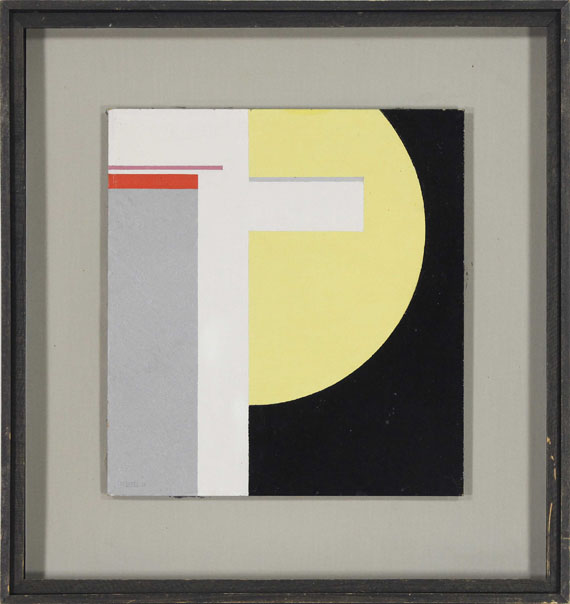346
Walter Dexel
Gelbe Halbscheibe mit Weiß und Grau, 1926.
Oil on cardboard, on panel
Estimate:
€ 80,000 / $ 92,800 Sold:
€ 100,000 / $ 115,999 (incl. surcharge)
Gelbe Halbscheibe mit Weiß und Grau. 1926.
Oil on cardboard, on panel.
Wöbkemeier 313. Signed and dated in lower left. 38.5 x 35.7 cm (15.1 x 14 in).
• Consistent provenance.
• The constructivist works from the 1920s are the artist's most sought-after works on the international auction market.
• In 1974 part of the comprehensive solo show at the Kestner Gesellschaft, Hanover.
• The respective reverse glass painting is in the Sprengel Museum, Hanover.
• Dexel's strictly puristic forms and compositions made for his prominent position among the Constructivists.
PROVENANCE: From the artist's estate.
Collection Grete Dexel, Brunswick.
Galerie Bargera, Cologne (around 1974, with a gallery label on the reverse).
Private collection France (acquired from aforementioned in 1975).
Private collection Belgium (inherited from above in 1999).
LITERATURE: Deutsches Kulturzentrum, Goethe-Institut, Paris, from February 15, 1972, leaflet no. 11.
Walter Dexel, Kestner Gesellschaft, Hanover, January 25 - March 3, 1974, cat. no. 229, p. 112 (with a exhibition label on the reverse).
Deutsche Konstruktivisten der 1920er Jahre. Baumeister, Buchheister, Burchartz, Dexel, Kandinsky, Kesting, Röhl, Stuckenberg, Vordemberge, Graphisches Kabinett Kunsthandel Wolfgang Werner, Bremen, November 21, 1974 - January 31, 1975, cat. no. 8 (titled "Komposition 1926").
Hauswedell & Nolte, Hamburg, 206th auction, 1975, lot 362, p. 117 (with illu.).
Oil on cardboard, on panel.
Wöbkemeier 313. Signed and dated in lower left. 38.5 x 35.7 cm (15.1 x 14 in).
• Consistent provenance.
• The constructivist works from the 1920s are the artist's most sought-after works on the international auction market.
• In 1974 part of the comprehensive solo show at the Kestner Gesellschaft, Hanover.
• The respective reverse glass painting is in the Sprengel Museum, Hanover.
• Dexel's strictly puristic forms and compositions made for his prominent position among the Constructivists.
PROVENANCE: From the artist's estate.
Collection Grete Dexel, Brunswick.
Galerie Bargera, Cologne (around 1974, with a gallery label on the reverse).
Private collection France (acquired from aforementioned in 1975).
Private collection Belgium (inherited from above in 1999).
LITERATURE: Deutsches Kulturzentrum, Goethe-Institut, Paris, from February 15, 1972, leaflet no. 11.
Walter Dexel, Kestner Gesellschaft, Hanover, January 25 - March 3, 1974, cat. no. 229, p. 112 (with a exhibition label on the reverse).
Deutsche Konstruktivisten der 1920er Jahre. Baumeister, Buchheister, Burchartz, Dexel, Kandinsky, Kesting, Röhl, Stuckenberg, Vordemberge, Graphisches Kabinett Kunsthandel Wolfgang Werner, Bremen, November 21, 1974 - January 31, 1975, cat. no. 8 (titled "Komposition 1926").
Hauswedell & Nolte, Hamburg, 206th auction, 1975, lot 362, p. 117 (with illu.).
After a few years of figurative painting with expressionist and cubist tendencies, Walter Dexel found a completely free, abstract visual language without any reference to reality in the 1920s. Through his friendships and close relationships with Bauhaus artists such as László Moholy-Nagy, the Dadaist Kurt Schwitters and the De Stijl artist Theo van Doesburg, he got to know constructivist painting. Around 1922 he eventually detached himself, also owed to the influences his artistic environment had on him, from the subject. With logical, mathematical-rational rules and the concentration on a few, simple elementary forms, he now composed clear, strictly geometric structures in almost puristic clarity, in which motif and background grow together and share a "common" surface. In ever new arrangements and variations, Dexel explored the fascinating relationship between colors, shapes, lines and, more rarely, letters and numbers within a rectangular image space. With regards to a later realization as a reverse glass painting, Dexel created a few very strong compositions in an almost squared format in 1926. This work presented here, with its strong contrasts and an almost poetic combination of strong, rich colors and delicately mixed tones, as well as with angular shapes, fine lines and a semicircle that loosens the composition up, must have been a composition the artist himself considered particularly felicitous, as he made a reverse glass picture of it the same year. Today it is part of the collection of the Sprengel Museum in Hanover. Dexel pursues his goal with a strong consistency that earned him an outstanding position among the constructivists of his time. Dexel had several shows at the Berlin gallery Der Sturm, among others, with Oskar Schlemmer and Willi Baumeister. With its strong contours, the clear forms and its unique poetic touch in the use of colors and in the arrangement of the forms, the work offered here also testifies to Dexel's important role in Constructivism of the early 20th century, as well as to the progressiveness and innovative creativity through which his astonishingly timeless work stands out to this day. [CH]
346
Walter Dexel
Gelbe Halbscheibe mit Weiß und Grau, 1926.
Oil on cardboard, on panel
Estimate:
€ 80,000 / $ 92,800 Sold:
€ 100,000 / $ 115,999 (incl. surcharge)
Headquarters
Joseph-Wild-Str. 18
81829 Munich
Phone: +49 89 55 244-0
Fax: +49 89 55 244-177
info@kettererkunst.de
Louisa von Saucken / Undine Schleifer
Holstenwall 5
20355 Hamburg
Phone: +49 40 37 49 61-0
Fax: +49 40 37 49 61-66
infohamburg@kettererkunst.de
Dr. Simone Wiechers / Nane Schlage
Fasanenstr. 70
10719 Berlin
Phone: +49 30 88 67 53-63
Fax: +49 30 88 67 56-43
infoberlin@kettererkunst.de
Cordula Lichtenberg
Gertrudenstraße 24-28
50667 Cologne
Phone: +49 221 510 908-15
infokoeln@kettererkunst.de
Hessen
Rhineland-Palatinate
Miriam Heß
Phone: +49 62 21 58 80-038
Fax: +49 62 21 58 80-595
infoheidelberg@kettererkunst.de
We will inform you in time.




 Lot 346
Lot 346 

